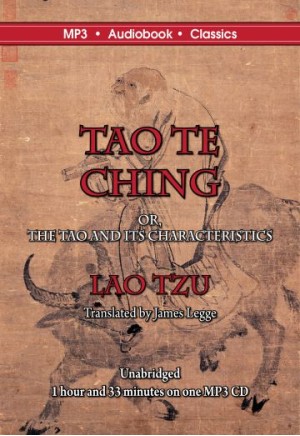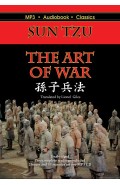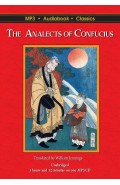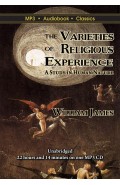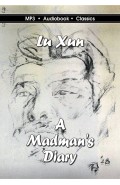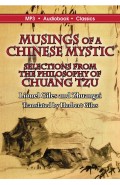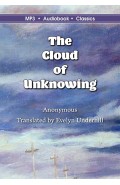Table of Contents
| Track | Section | Length |
| 1 | Tao Te Ching Chapters 1-9 | 8:46 |
| 2 | Tao Te Ching Chapters 10-18 | 10:08 |
| 3 | Tao Te Ching Chapters 19-27 | 10:38 |
| 4 | Tao Te Ching Chapters 28-37 | 11:03 |
| 5 | Tao Te Ching Chapters 38-45 | 10:14 |
| 6 | Tao Te Ching Chapters 46-54 | 10:01 |
| 7 | Tao Te Ching Chapters 55-63 | 11:58 |
| 8 | Tao Te Ching Chapters 64-72 | 10:10 |
| 9 | Tao Te Ching Chapters 73-81 | 10:16 |
Notes
Running Time: 1 hours 34 minutes
Read by: Eric S. Piotrowski
Meta Coordinator: Annie Coleman Rothenberg
Artwork
Cover: Laozi Riding an Ox, hanging scroll, light color on paper. Located at the National Palace Museum. Laozi is carrying a copy of the Dao De Jing. Middle Ming Dynasty (1368–1644) Zhang Lu
Inset: Pakua with frame, 1 September 2007, Benoît Stella alias BenduKiwi.
Inset: Confucius presenting the young Gautama Buddha to Laozi. Qing Dynasty.
Insert: Background same as cover. The Yin and Yang with white representing Yang and black representing Yin. December 7, 2007, Klem.
Recordings
These recordings were made using the author’s original published work, which is in the public domain. The readings were recorded by members and volunteers of Librivox.org, which has generously made the recordings available to the public domain. The audio files have been lightly edited and have been engineered using professional audio tools for maximum sonic quality. While Librivox condones the sale and distribution of these recordings, it is not associated with the management or operations of MP3 Audiobook Classics.
The Tao Te Ching is an ancient Chinese classic text written by the sage Lao Tzu in the sixth century BC. Also spelled as Tao Teh King, Daodejing and Dao De Jing, and referred to in China simply as Laozi or Lao Tsu, it can be translated into English as “The Classic Book of the Virtuous Way”. (“Tao” means “way “de” means “virtue” or “integrity”; and “ching” means “great book” or “classic”.) The first verse famously sets out the ineffable mystery of the Tao, which is nameless, beyond words and distinctions, passive, intuitive, and attentive to wu wei, or effortless action.
The book is a sequence of 81 short poems structured in two parts – the Tao Ching (chapters 1-37) and the Te Ching (chapters 38-81). The style combines two elements: laconic, poetic, and memorable declarative statements and intentional contradictions that force the listener to reconcile the resulting ambiguities. The absence of grammatical connectors increases the ambiguity and gives rise to endless varying interpretations. The Tao Te Ching has a long and complex history and an abundant body of scholarship resulting from the study of three versions ranging from the second century BC to the third century AD. The oldest version dated prior to 300 BC was discovered in 1993 and consists of 800 slips of bamboo.
The Tao Te Ching is a fundamental text in both religious and philosophical Taoism and has greatly influenced Confucianism, Legalism, and Chinese Buddhism, which was originally introduced to China through Taoist concepts and terminology. It is a continuing source of inspiration to Chinese artists and is one of the most translated works in all of world literature.
Play sample:
Download a PDF datasheet
| Item Info | |
| EAN - DVD case | 0683422134333 |
| EAN - CD jacket | 0682550992730 |
| Media | MP3 CD |
| Package | DVD Box |
| Author | Lao Tzu (6th Century BCE) |
| Translator | James Legge (1815 - 1897) |
| Year | c. 600 BCE |
| Recording | |
| Read by | Eric S. Piotrowski |
| Length | 1 hour and 34 minutes |
| Type of Reading | Solo |
The Tao Te Ching, or, The Tao and its Characteristics
- Author: Lao Tzu
- Product Code: DB-1131
- Availability: In Stock
-
$9.99
Available Options
Related Products
The Art of War
The Art of War by Chinese general Sun Tzu is considered by many to be the single best book ever writ..
$9.99
The Analects of Confucius
The Analects of Confucius is a collection of anecdotes, sayings and ideas attributed to the Chinese ..
$9.99
The Varieties of Religious Experience
The Varieties of Religious Experience: A Study in Human Nature by William James is an edited collect..
$13.99
A Madman's Diary
“A Madman’s Diary” is a short story by Lu Xun first published in 1918. Written in vernacular Chine..
$7.99
Musings of a Chinese Mystic
If Lao Tzu then had revolted against the growing artificiality of life in his day, a return to natur..
$9.99
The Cloud of Unknowing
The Cloud of Unknowing is an anonymous work of Christian mysticism written in Middle English in the ..
$8.99

